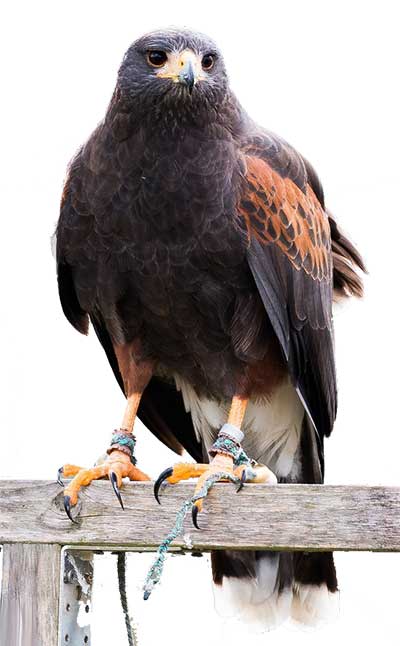
1. Training: Harris's hawks are known for their intelligence and ability to work cooperatively with humans. Training a Harris's hawk for falconry involves building a strong bond with the bird through positive reinforcement and consistent training techniques. This process begins with a technique called ‘manning’ in which the falconer sits and carries the Harris’s hawk on their glove for an extended period of time to allow the bird to become comfortable with their trainer. Once the bird is comfortable, a relationship with food and the falconer is made through a series of jumps to the glove. This process leads to the bird flying on a creance. Once the bird can consistently fly sixty feet or more to the glove while on a creance, the hawk is ready for free flying. At this point, items like a lure or what is known as a ‘baggie’ are good training techniques to get the bird used to capturing prey. Once your bird successfully predates on lures or baggies, they are ready for hunting in the wild.
2. Hunting: Harris’s hawks are skilled hunters and are known for their ability to work together in a team to capture prey. In falconry, the Harris’ hawk is trained to pursue and capture game under the guidance of the falconer. When flying a Harris’ hawk for wild game, their main pursuit will be for small ground mammals such as squirrels, rats, and rabbits. It is important to know which type of game is suited for the bird of prey you are training before hunting with a bird of prey.
3. Equipment: Falconry equipment includes specialized leather jesses, anklets, swivels, and leashes for the hawk, as well as a leather hood to cover the hawk's eyes when not hunting. The falconer also uses a glove to handle the bird. The most typical type of anklets for birds of prey is known as a Aylmeri anklet. These anklets are made of leather and secured around both legs of the bird and attached with a brass attachment known as an eyelet. The eyelet allows for the jesses to be attached to the bird. There are two types of jesses used for different occasions; mews jesses and hunting jesses. Although both made of leather, mews jesses are the longer of the two and have slits in them to attach to a swivel and leash where field jesses are shorter and do not have a slit as to avoid the bird getting caught on a tree brach or other obstacle while free flying. Swivels are typically made from stainless steel and help to attach the jesses to the leash. Due to the unique construction of a swivel it allows for the jesses and the leash to ultimately move independently which helps to reduce tangling. The leash can come in many different materials including leather and rope. This piece of equipment attaches the swivel to either a perch or falconry glove. The swivel and leash are only used when transporting or tethering a bird to a perch; these pieces of equipment are never left on while the bird is free flying. Depending on the type of hawk you are working with a leather hood may not be necessary. Since harris’s hawks are typically social birds, they don’t get as stressed out in situations with humans and other birds as much as say a peregrine falcon would. In lieu of a leather hood, many falconers use something called a ‘giant hood’ to transport their bird, which is essentially a carrier for birds.
4. Laws and regulations: Falconry is regulated in many countries, and falconers are required to obtain permits and adhere to specific guidelines for the capture, training, and care of their birds. It's important to be aware of and comply with local laws and regulations related to falconry. In Canada it is not required to obtain a falconry licence to practice falconry with non-indigenous birds, it is only required that you have a small game hunting licence and you may require a variety of permits. Although it is not a necessity if are flying a non-indigenous bird like the Harris’s hawk, it is highly recommended you do obtain a licence before owning a bird of prey or pursuing falconry; and here’s why. Birds of prey can develop many different illnesses and injuries that a novice falconer would not be able to recognize. It is very important to learn about the health, care, and welfare of birds of prey before deciding to get one. A sponsor is someone who will take you through the proper channels for obtaining a falconry licence, assist you with the proper training, and make sure you know everything required of you as a falconer. Also, if you wish to practice falconry with any indigenous birds such as the Red-tailed hawk, a falconry licence if 100% mandatory.
5. Ethics and conservation: Falconers are typically strong advocates for the conservation of raptors and their natural habitats. Many falconers are involved in raptor rehabilitation and release programs and contribute to scientific research on raptors. Assisting in these types of services or knowing where to send a captured bird that requires rehabilitation is key before performing a wild capture. Doing a full health assessment of your bird, knowing what to look for, and how to assist your bird in these situations are important before housing or releasing a captured bird back into the wild.
Falconry with Harris's hawks requires dedication, patience, and a deep respect for the birds and their natural instincts. It's a time-honored tradition that continues to thrive as both a cultural practice and a form of wildlife conservation.













